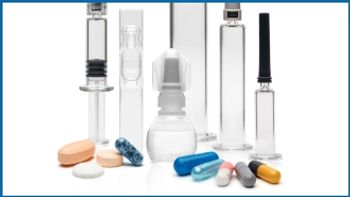
- BioPharm International-10-01-2017
- Volume 30
- Issue 10
Formulation of Biologics for Non-Invasive Delivery
There is a lot of interest in delivering biologics via non-invasive routes in attempt to improve patient compliance and convenience.
The biologics market is projected to reach $399.5 billion by 2025, according to a report by Grand View Research (1). Growth is being driven by a number of factors including the superior efficacy and safety of biologics as a result of specific drug targeting, an aging population, and the shift toward personalized medicines. The drug development process for biologics, however, is not as straightforward as that for small-molecule drugs. Unlike small molecules that can be chemically synthesized, biologics are produced in genetically modified living cells using recombinant DNA technology. The complexity and size of these macromolecules not only present challenges in the manufacturing step, but also in formulation development.
“There is tremendous pressure to shorten the formulation development timeline to accelerate product development,” Jay Kang, director, Analytical & Formulation Development, Patheon, notes. “But the instability of a product because of poor formulation development can result in clinical hold and put the whole program at risk.”
Kang explains that the instability of a biologic can be caused by aggregation, deamination, isomerization, hydrolysis, oxidation, and denaturation. “The tendency of a biologic to exhibit these structural modifications depends on the properties of the protein and environmental factors including temperature, pH, and the ionic strength of the surrounding environment,” he says. “Several excipients have been tested to increase the stability of biologics, including the use of disaccharides and non-ionic surfactants. Although many of these agents are effective stabilizers, their use requires careful consideration in terms of local toxicity and potential immunogenicity. Understanding the mechanism of inactivation of biopharmaceutical drugs is crucial and can enable a rational approach to determine what excipients should be used for stabilization.”
Enrico Corona, director of Pharmaceutics & Process Technology, Patheon, highlights that because formulation development often occurs in parallel with process development, scientists not only have a limited supply of material, but they are also using materials that might not be representative to the final process. “Critical quality attributes (CQAs) are not clearly defined for novel biologics,” he says. “A lot of CQAs are based on similar molecules initially, which might not be the case. This poses challenges in making effective formulation decisions.”
Moreover, because of their high molecular mass, biopharmaceuticals have lower permeability across biological barriers such as the skin, mucosal membranes, and cell membranes, Corona points out. “For this reason, injection is the primary mode of administration for most biopharmaceuticals,” he adds. Injections are not ideal, especially for chronic conditions. The pain and inconvenience caused by this invasive route can have a negative impact on patient compliance and quality of life.
Oral delivery
Oral delivery offers advantages to both patients and manufacturers, but for biopharmaceuticals, success has been limited. “Both industry and academia have spent significant amount of resources on this effort,” Kang observes. “However, avoiding degradation in the harsh gastrointestinal environment as well as transporting large and hydrophilic biologic molecules into the blood stream remains a challenge. Until we see a breakthrough in both areas, oral delivery of biologics will remain an elusive goal for formulation scientists.”
David Lyon, head of biotherapeutics, Capsugel, now a Lonza company, notes that oral delivery of biologic APIs-mainly peptides and proteins-has been the “holy grail” of pharmaceutical drug delivery for the past several decades. “The delivery of biologic APIs is challenged by both physical-chemical properties of the molecules as well as the biology of the gut,” he explains. “Specifically, the challenges include hydrolytic sensitivities of the molecules to the acidic media in the stomach as well as the enzymatic activity of the intestine.”
Lyon adds that peptides and proteins have high molecular weights and are highly hydrophilic. Such properties are opposite to those required for passive permeation of molecules across the gut epithelium. “The stability of peptides and proteins to temperature, pH, and in some cases, light can also have an important impact on manufacturing,” he says. “And in such cases, a delicate balance between the formulation process and process conditions and the stability of the biologic API will be required.”
Inhaled or nasal delivery
Ryan Klein, senior director of R&D at Tergus Pharma, notes that the limited success of delivering biologics via the oral route has led to the exploration of other delivery sites such as the lungs and the skin. The inhaled or nasal route, for example, has attracted a great deal of interest, not only because of its potential for direct delivery of the drug locally to the respiratory system, but also as an alternative systemic delivery route.
“As a systemic dosing route, inhaled and nasal delivery presents a more patient-friendly alternative to parenteral delivery. It also has potential advantages in pharmacokinetic profiles compared to other options such as subcutaneous injection,” says Mark Parry, technical director, Intertek Melbourn (2). “Topical delivery, on the other hand, allows targeting of the drug to the site of action with a potentially lower dose than would be needed for systemic intravenous (IV) dosing-for example, in the treatment of a lung infection or delivery of a gene therapy to the lungs of a cystic fibrosis sufferer.”
According to Lyon, nasal delivery can be limited by surface area and rapid mucous turnover. “But the lung has a large surface area and a relatively porous membrane that it offers a good non-invasive target for the delivery of peptides and proteins,” he says, citing Alfrezza, an inhaled insulin product developed by MannKind Corporation, as an example.
A number of devices are used to deliver drugs via the inhaled or nasal route, from nebulizers and nasal sprays to dry powder inhalers (DPI) and pressurized metered-dose inhalers (pMDI). Ashleigh Wake, director of Biological Services, Intertek Manchester, highlights that device selection should take into account factors relating to both the properties of the compound being developed as well as the intended usage model of the product. “There are also related commercial considerations to be factored in,” she says (2).
“Some compounds may need to be present as a solid material because they lack long-term stability in solution; DPI products are advantageous in such cases, besides the additional benefit of patient convenience. However, engineering a DPI formulation requires the development of a suitable spray-drying process (or other suitable particle-engineering technique), which adds complexity and cost to the product and its development,” Parry explains (2).
“At Capsugel, we have developed a spray-drying/particle-engineering technology that allows the gentle processing of biologic APIs into room temperature-stable formulations that can then be inhaled using specially designed DPI capsules (for optimized clearance of the drug) and readily available DPI devices,” Lyon says. “Capsugel has progressed more than 10 inhaled peptides and proteins that are now in various stages of development.”
Despite some of the advantages of a DPI formulation, nebulized and nasal solution and reconstituted solution products tend to dominate current developments, according to Parry. Lyon points out that nebulizers and pMDIs require the biologic to be presented as a solution. “While many proteins can be stabilized in solution, this often requires cold-chain storage (2–8 °C) to keep the protein in its correct three-dimensional structure,” he says. “Also, nebulization and pMDIs are generally considered less convenient for the patient and more challenging from a patient compliance perspective.”
According to Lyon, dry powder formulations offer the advantage of better patient compliance as well as being room temperature stable when properly formulated. Parry also agrees that the advantages of a simpler, shorter inhaled dosing process as well as improved shelf lives make DPI products more commercially desirable.
“In terms of device compatibility, one of the early parts of development is to look at the compatibility of the product with the materials and methods of operation of the chosen devices,” says Wake. “For example, the aerosolization of solutions for nebulization can impart significant shear forces as well as increased exposure to oxygen in the air, which must be assessed in order to select an appropriate delivery device.” She explains that biologics can suffer from changes in activity and structure when exposed to extreme conditions, as typical of a nebulized or nasal system. It is, therefore, important to ascertain if the delivery mechanism has adversely affected such parameters (2).
Besides the typical quality control criteria of assay, purity, and impurities, inhaled and nasal products requires specific testing to look at the product performance, Parry points out. “These tests include measuring the delivered dose (i.e., the actual amount delivered by the device to the patient) and the particle or droplet size, which affects where the product will deposit,” he says (2). “These parameters are critical for inhaled and nasal product performance as they ensure that the right amount of drug is delivered to the right part of the nose or lungs, and are key stability indicating tests for development and routine testing of these product types.”
Skin delivery
The potential of delivering biologics through the skin is also being explored. “Biologics as topical treatments are playing an increasing role in treating a variety of skin conditions,” says Klein. He highlights, however, that there are unique challenges in delivering such large molecules across the skin given its function as a protective barrier. “The compact structure and hydrophobic nature of the stratum corneum is the primary barrier,” he says. “As a result, the cutaneous delivery of biologics typically requires the use of penetration enhancers or some other physical or chemical disruption of this skin layer.”
Despite these challenges, Klein sees great opportunities for delivering biologics via the topical route, particularly for the treatment of skin conditions. “The advantages of topical delivery of biologics include direct treatment at the site of the disease, the avoidance of hepatic first pass metabolism, extended delivery times that can prolong the pharmacodynamic effect at the site of action in the skin, and the flexibility to remove the delivery system to discontinue administration of the drug,” he explains.
From a formulation perspective, Klein stresses that it is important to select excipients and penetration enhancers that allow the drug to maintain its efficacy and reach the target site in sufficient quantities. “The tertiary structure of large molecules is crucial to their efficacy, and this conformation can be highly sensitive to certain excipients and processes used to formulate the final product,” he says. He adds that chemical degradation, aggregation, and conformational denaturation can lead to a significant decrease in efficacy. “Factors such as pH, salt content, shear, and heat that typically have minimal impact on conventional small molecules can have a significant impact on a biologic,” he says. “Thus, appropriate solvents and excipients should be carefully selected to ensure they are fully compatible with the drug substance in the final dosage form (i.e., cream, lotion, gel, ointment). The final process should be thoroughly evaluated and the design space fully characterized to establish the impact of manufacturing process on the final product.”
According to Klein, most alcohols are incompatible with peptides and proteins and should, therefore, be avoided as solvents in favor of aqueous buffer systems that provide a more stable environment for biologics. “To optimize product shelf life, preservatives and stabilizers may also be necessary and should be added to maintain pH and prevent oxidation. Typical stabilizers include methionine, glutathione, and trehalose,” he says.
Klein notes that penetration enhancers are often required to enhance the delivery of large molecules, but must be selected carefully to ensure compatibility. “Many conventional penetration enhancers exert their effect due to their ability to disrupt the biological environment of the skin, and therefore, are not compatible with large molecules in the formulation,” he explains. “Specific enhancers that are amenable to most biologics include isopropyl myristate, propylene glycol, and N-methylpyrrolidone.”
Microneedle delivery
Another alternative to injections, for biologics, is the transdermal route, which offers the possibility of a faster onset of action compared to subcutaneous administration, according to Lisa Dick, microstructured transdermal system (MTS) new technology and product development manager, 3M Drug Delivery Systems. “Microneedle delivery provides an alternative to standard syringes and needles or autoinjectors,” she says. “For needle-phobic patients, microneedles are less threatening than standard injection needles.”
For transdermal products, the drug molecule needs to be relatively small (i.e., several hundred atomic mass units) and permeable through the stratum corneum, observes Mark Tomai, head of Toll-Like Receptor (TLR) and MTS Business Development, 3M Drug Delivery Systems. “Most biologic drugs are too large for passive intradermal delivery,” he says, “that’s why microneedle-based delivery systems have been developed.” 3M has developed hollow and solid microneedle systems, which use biocompatible polymeric microneedles to bypass the barrier properties of the stratum corneum.
The hollow microneedle technology by 3M is a single-use delivery system designed for self-administration. Liquid formulations are contained in a reservoir and delivered into the skin via a 1-cm2 microneedle array. The microneedles can accommodate a range of molecules and drug volumes of up to 2 mL, as long as stability in the liquid form is maintained (3).
“For liquid formulations delivered through hollow microneedles, skin tolerability and viscosity are key considerations during formulation development,” says Tomai. “Non-viscous formulations flow readily through the narrow flow paths in the microneedle-based devices, but viscous formulations are more likely to require a long delivery time due to back pressure from the skin toward the volume being delivered.” According to Tomai, it is possible to deliver more viscous solutions of up to approximately 25 centipoise (cp) with the 3M hollow microstructured transdermal system (hMTS), and there are options for delivery of up to 80 cp solutions in the future (2).
Dick stresses the importance of ensuring that the drug product formulation is chemically compatible with the microneedle array and device, including storage over time. “Drug molecules in a liquid formulation that are delivered using a hollow microneedle injector must be physically able to withstand shear forces when flowing through the device. Such physical compatibility considerations are especially important for biological drugs, which can denature or become inactive,” she explains (2).
3M’s solid microneedle technology is based on tiny needles mounted on a wearable patch, which has been designed to deliver proteins, vaccines, or other solid formulations up to 300 mcg (4). “In this case, the drug is coated on the microneedle patch and these systems have the advantages of having many short microneedles, being easy for a patient to self-administer, and potentially being stable at room temperature,” says Dick. There are, however, several formulation considerations that need to be taken into account, for example, the balance between chemical stability, the ability to coat onto solid microneedles, and the ability of the formulation to release into the skin, Tomai highlights. “Chemical stability considerations are similar to those of other dosage forms. The ability to coat a formulation onto solid microneedles is drug dependent and relies on solubility, target dose, and viscosity. For the ability of a formulation to release into the skin, it needs to be released from the microneedle surface through its inherent solubility in the dermal interstitial fluid,” he says. There may be more than one acceptable formulation composition for a drug molecule, Tomai points out, therefore, it is a matter of testing several formulations for manufacturability and the eventual outcome for effective treatment (2).
Trends in biologics drug development
The impending patent expirations of biologic blockbusters continue to fuel the development of biosimilars. There is a lot of pressure for faster formulation development as companies strive to quickly file an investigational new drug application, according to Kang and Corona. “Most companies are using high throughput methods to screen large amounts of buffer/excipients more quickly and efficiently. There is also the development of kinetic models to predict drug product expiration dates based on stressed or accelerated stability results,” they say. “In addition, we see increasing emphasis by regulators on efforts to measure, characterize, and control subvisible particles in biologics.”
There is, at the same time, a shift toward the development of formulations that are more convenient for patients. With key biologics coming off patents, there are opportunities for product differentiation, such as delivering biologics via non-invasive routes. Lyon believes that in the near future oral delivery of biologic APIs will be fairly common for APIs treating local gut disease states, such as Crohn’s and irritable bowel syndrome. “This delivery modality will require protection from acid-based hydrolysis using enteric-coated multiparticulates or an intrinsically enteric capsule technology (e.g., Capsugel’s enTRinsic drug-delivery technology).” However, he highlights that significant breakthroughs will have to be made to translate currently marketed biologic APIs from IV delivery to drug products delivered orally.
References
1. Grand View Research, “Biologics Market Size Worth $399.5 Billion by 2025,” Press Release, March 29, 2017.
2. A Siew, PharmTech 41 (5) 30-33 (2017).
3. 3M,
4. 3M,
Article Details
BioPharm International
Volume 30, Number 10
October 2017
Pages: 12–17
Citation
When referring to this article, please cite it as A. Siew, “Formulation of Biologics for Non-Invasive Delivery,” BioPharm International 30 (10) 12–17 (2017).
Articles in this issue
about 8 years ago
Improved Materials Enhance Parenteral Packagingabout 8 years ago
Pharma’s Role in Puerto Rico’s Futureabout 8 years ago
Control Viral Contaminants with Effective Testingabout 8 years ago
FDA User Fees Promote Manufacturing Readinessabout 8 years ago
Up and Away, M&Aabout 8 years ago
Making Decisions Based on Riskabout 8 years ago
The Challenges of PAT in the Scale-Up of Biologics Productionabout 8 years ago
Optimizing Protein Aggregate Analysis by SECabout 8 years ago
Development of Purification for Challenging Fc-Fusion ProteinsNewsletter
Stay at the forefront of biopharmaceutical innovation—subscribe to BioPharm International for expert insights on drug development, manufacturing, compliance, and more.





